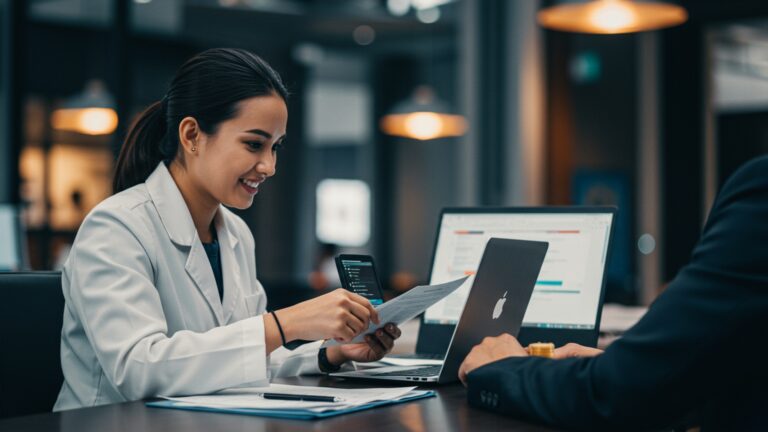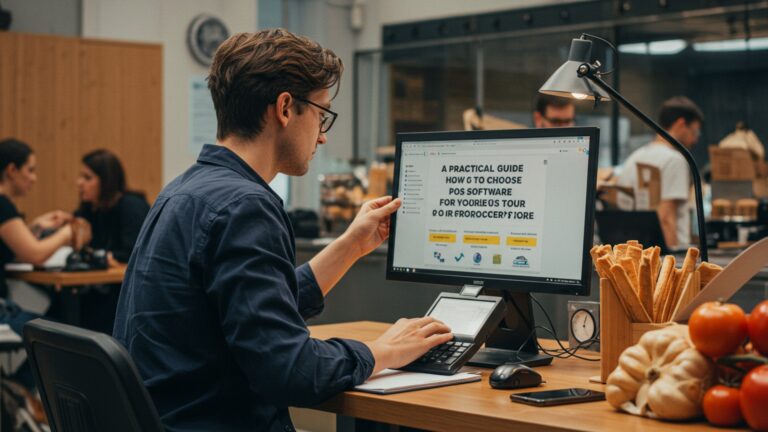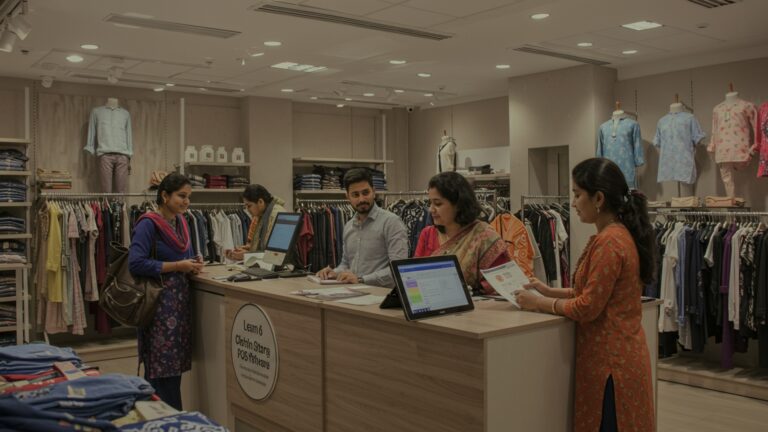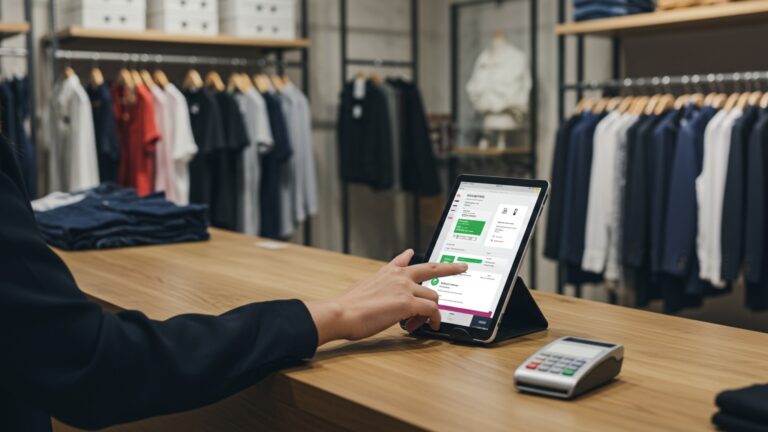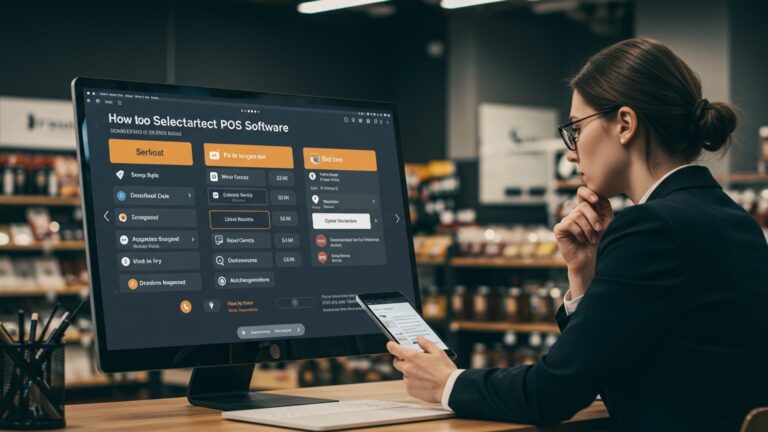How to Implement POS Software for Your Grocery Store Seamlessly
The modern grocery landscape is fiercely competitive, with slim margins and evolving consumer demands for frictionless experiences and personalized offers. Gone are the days when a simple cash register sufficed; today, a robust pos software for grocery store is not just a convenience but a strategic imperative. Effective implementation empowers retailers to move beyond basic transaction processing, transforming their system into a central nervous system for operations. This enables crucial functions like precisely managing perishable inventory to minimize waste, accelerating checkout lines even during peak hours. leveraging real-time sales data for predictive ordering or seamless integration with evolving e-commerce platforms. Mastering your POS solution is essential for enhancing efficiency and driving growth in today’s dynamic market.

Understanding the Power of POS for Grocery Stores
In today’s fast-paced retail environment, a grocery store’s success hinges significantly on efficiency, accuracy. customer experience. This is where a robust Point of Sale (POS) system becomes indispensable. A POS system is far more than just a cash register; it’s a comprehensive software and hardware solution that centralizes essential business operations, from processing transactions to managing inventory and tracking sales data.
For grocery stores specifically, a specialized pos software for grocery store offers tailored functionalities to address unique challenges. Imagine instantly knowing your exact stock levels for every item, from fresh produce to canned goods, or processing a customer’s entire cart in seconds, including weighted items and loyalty discounts. This level of operational insight and speed is precisely what a modern POS system delivers.
Key benefits that grocery stores gain from implementing the right POS software include:
- Accelerated Checkout
- Precise Inventory Management
- Enhanced Customer Experience
- Robust Reporting and Analytics
- Streamlined Operations
- Loss Prevention
Reduce wait times with quick barcode scanning, integrated scales. efficient payment processing.
Track every item in real-time, manage expiry dates for perishables, automate reordering. minimize waste and shrinkage.
Implement loyalty programs, offer personalized promotions. maintain customer purchase history for better service.
Gain valuable insights into sales trends, peak hours, popular products. staff performance to make data-driven decisions.
Manage multiple departments, integrate with accounting software. improve overall operational flow.
Reduce theft and errors through accurate transaction recording and inventory tracking.
By understanding these foundational advantages, grocery store owners can approach POS implementation not as a mere upgrade. as a strategic investment in their store’s future.
Phase 1: Strategic Planning and Needs Assessment
The journey to seamless POS implementation begins long before you even look at software options. It starts with a thorough strategic planning and needs assessment phase. This crucial step ensures that the chosen pos software for grocery store aligns perfectly with your specific operational requirements and business goals.
Begin by identifying your current pain points. Are your checkout lines too long? Is inventory frequently inaccurate? Do you struggle with managing produce waste? Documenting these challenges will help you prioritize the features you need most. Involve key stakeholders from various departments—cashiers, store managers, inventory staff. even your accounting team—to gather diverse perspectives. Their input is invaluable in shaping a comprehensive requirements document.
Consider the following during this phase:
- Define Objectives
- Budget Allocation
- Scalability Needs
- Integration Requirements
- Technical Infrastructure
What do you aim to achieve with the new POS? (e. g. , “Reduce checkout time by 20%”, “Improve inventory accuracy to 98%”, “Launch a customer loyalty program”).
Determine a realistic budget for software licenses, hardware, installation, training. ongoing support.
Do you plan to expand to multiple locations or significantly increase your product offerings in the future? Ensure the chosen system can grow with you.
What other systems need to integrate with your POS (e. g. , accounting software, e-commerce platform, supplier ordering systems)?
Assess your current network capabilities, internet reliability. existing hardware.
Create a detailed “Requirements Document” that outlines all desired features, integration needs, budget constraints. long-term goals. This document will be your compass for the entire implementation process.
Phase 2: Selecting the Ideal POS Software for Your Grocery Store
Choosing the right pos software for grocery store is perhaps the most critical decision in the entire implementation process. The market offers a wide array of solutions, each with varying features and capabilities. Your requirements document from Phase 1 will be instrumental here.
Look for software that offers specific functionalities tailored to grocery operations:
- Integrated Scales & Barcode Scanning
- Perishable Inventory Management
- Customer Loyalty Programs
- Multi-Store Capabilities
- Supplier and Purchase Order Management
- Robust Reporting and Analytics
- Payment Processing Flexibility
Seamless compatibility with deli scales, produce scales. fast, accurate barcode scanners.
Features for tracking expiry dates, lot numbers. managing spoilage to reduce waste.
Built-in tools for creating and managing loyalty points, discounts. customer databases.
If you operate multiple locations, ensure the software can centralize data and management across all stores.
Streamline communication with suppliers and automate inventory replenishment.
Detailed sales reports, inventory turnover, employee performance. customer insights.
Support for various payment methods including credit/debit cards, mobile payments. EBT.
Consider the deployment model: cloud-based versus on-premise solutions. Here’s a quick comparison:
| Feature | Cloud-Based POS (SaaS) | On-Premise POS |
|---|---|---|
| Hosting | Vendor’s servers (accessed via internet) | Your store’s local servers |
| Upfront Cost | Lower (monthly subscription) | Higher (software license, server hardware) |
| Maintenance | Managed by vendor | Managed by your IT team or third-party |
| Accessibility | Anywhere with internet connection | Primarily on-site (can be configured for remote access) |
| Data Security | Managed by vendor (usually robust) | Your responsibility |
| Updates | Automatic, seamless | Manual, often requiring downtime |
| Scalability | Easily scalable | Requires hardware upgrades |
Beyond features and deployment, evaluate vendor reputation, customer support quality. pricing models. Don’t hesitate to request demos and, if possible, leverage trial periods to get a hands-on feel for the software. Speak to other grocery store owners who use the prospective system to gather real-world insights.
Phase 3: Data Migration – Your Store’s Digital Foundation
Once you’ve selected your pos software for grocery store, the next critical step is data migration. This involves transferring all your existing product, customer. historical sales data into the new system. Accurate and thorough data migration is the bedrock of a successful POS implementation; errors here can lead to significant operational headaches down the line.
The primary types of data to migrate include:
- Product Catalog
- Customer insights
- Historical Sales Data
- Vendor details
SKUs, item descriptions, current pricing, cost, department, category, vendor insights, tax rates. inventory quantities. For grocery, this also includes unit of measure (e. g. , per pound, per item). potentially expiry dates.
Names, contact details, loyalty program points, purchase history (if migrating from an older system).
While not always critical for day-to-day operations, migrating historical sales can provide valuable long-term trend analysis.
Contact details, payment terms, product lists from suppliers.
Before migration, a crucial step is data cleansing. This means identifying and correcting errors, removing duplicates. standardizing formats. For example, ensure all product names follow a consistent convention. all SKUs are unique. Neglecting data cleansing can lead to incorrect pricing, inventory discrepancies. frustrated customers.
Migration strategies can vary:
- Manual Entry
- Spreadsheet Import
- API Integration
For very small stores with limited inventory, this might be feasible but is highly prone to errors and time-consuming.
Most POS systems allow bulk import via CSV or Excel files. This requires meticulous formatting of your existing data to match the new system’s requirements.
For more complex setups or if you’re migrating from an existing digital system, an API (Application Programming Interface) can automate data transfer directly between systems. This typically requires technical expertise.
A small family-owned grocery store, “Fresh Harvest Market,” decided to migrate from an old, manual system to a modern pos software for grocery store. They dedicated two weeks to meticulously cleaning their product data, ensuring every item had a unique SKU, accurate pricing. correct category assignments. They also physically counted their entire inventory to ensure starting stock levels were precise. This rigorous data preparation, though time-consuming upfront, allowed for a seamless spreadsheet import and prevented any pricing or inventory errors once the new system went live, saving them countless hours of troubleshooting later.
Always perform thorough testing after migration to verify data integrity. Check a representative sample of products, prices. customer records to ensure everything transferred correctly.
Phase 4: Hardware Integration and Network Setup
With your software chosen and data migrated, the next step is setting up the physical infrastructure. This involves selecting, installing. integrating the necessary hardware components and ensuring your network can support the new system. The right hardware complements your pos software for grocery store, ensuring smooth operations at the checkout and back office.
Essential hardware components for a grocery POS include:
- POS Terminal
- Barcode Scanner
- Receipt Printer
- Cash Drawer
- Payment Terminal (PIN Pad)
- Weighing Scales
- Label Printers
- Customer-Facing Display
Often a touchscreen monitor or all-in-one PC, serving as the central interface for transactions. Tablets are also increasingly popular for their flexibility.
Crucial for rapid item entry. Consider 2D imagers for scanning QR codes or digital coupons. ensure they can read barcodes on various surfaces, including curved produce.
Thermal printers are common for their speed and quiet operation, typically printing on rolls of thermal paper.
Securely integrated with the POS system to open automatically upon cash transactions.
EMV-compliant (chip card reader) and NFC-enabled (contactless payments like Apple Pay, Google Pay) are essential for modern payment processing.
Crucial for produce, deli. bulk items. Ensure direct integration with your POS software for accurate pricing based on weight.
For printing barcode labels for bulk items or items without pre-existing barcodes.
Shows customers their itemized purchases and total, improving transparency and reducing errors.
A reliable and secure network is the backbone of any modern POS system, especially for cloud-based solutions. Ensure you have:
- Stable Internet Connection
- Secure Wi-Fi (if applicable)
- Ethernet Cabling
- Network Security
High-speed and reliable internet is paramount for cloud-based POS and payment processing. Consider a backup internet solution (e. g. , a cellular hotspot) for emergencies.
If using wireless terminals or tablets, ensure your Wi-Fi network is robust, secure (WPA2/WPA3). has adequate coverage throughout the store.
For stationary POS terminals, a wired Ethernet connection is generally more stable and faster than Wi-Fi.
Implement firewalls and network segmentation to protect sensitive customer and payment data. Work with an IT professional to ensure PCI DSS compliance if you process credit card payments.
Installation should be done systematically, ensuring all components are correctly connected, configured. communicating with the POS software. Test each piece of hardware thoroughly (scanner, printer, payment terminal, scale) before moving on.
Phase 5: Comprehensive Staff Training and System Configuration
Even the most advanced pos software for grocery store is only as good as the people operating it. Comprehensive staff training is paramount for a smooth transition and to maximize the benefits of your new system. Alongside training, meticulous system configuration ensures the software operates precisely as your store needs it to.
Training should be role-based, addressing the specific functions each employee will perform:
- Cashiers
- Store Managers
- Inventory Staff
Focus on transaction processing (scanning, weighing, discounts, returns, voids, payment methods), opening/closing shifts. basic troubleshooting.
Cover all cashier functions, plus inventory management (receiving, transfers, adjustments), reporting, employee management, promotions. advanced troubleshooting.
Deep dive into stock management, ordering, receiving, managing expiry dates. conducting inventory counts.
Key aspects of effective training:
- Hands-on Practice
- Step-by-Step Guides
- Role-Playing Scenarios
- Q&A Sessions
- Refresher Training
Provide a dedicated training environment or “sandbox” mode where staff can practice without affecting live data.
Create easy-to-follow cheat sheets or laminated cards for quick reference at each station.
Simulate common and uncommon situations (e. g. , customer return without a receipt, price override, gift card redemption).
Encourage questions and address concerns openly.
Schedule follow-up sessions after the initial go-live to reinforce learning and address new questions.
This involves tailoring the POS software to your store’s specific operational policies and pricing strategies:
- User Roles and Permissions
- Discounts and Promotions
- Loyalty Programs
- Tax Rates
- Payment Methods
- Receipt Customization
- Inventory Thresholds
Define who can access specific functions (e. g. , only managers can issue refunds over a certain amount).
Set up various types of discounts (e. g. , “buy one get one free,” percentage off, loyalty points redemption).
Configure how points are earned and redeemed. how customer data is managed.
Ensure all local, state. federal tax rates are correctly applied to different product categories.
Configure all accepted payment types, including credit/debit, gift cards, EBT. mobile payments.
Design your receipts to include your store logo, contact insights. return policies.
Set minimum stock levels to trigger automated reorder alerts.
It’s beneficial to have a designated “super-user” or project lead who is thoroughly trained on all aspects of the system and can act as an in-house expert for ongoing support and training.
Phase 6: The Go-Live Day and Post-Implementation Support
The “Go-Live” day is the culmination of all your planning and preparation. While exciting, it’s also a period that requires careful management to ensure a smooth transition. A well-executed launch and robust post-implementation support are crucial for the long-term success of your pos software for grocery store.
- Verify all hardware is installed and tested.
- Confirm data migration is complete and accurate.
- Ensure all staff have completed training.
- Test all system configurations (discounts, taxes, payment types).
- Have vendor support contact insights readily available.
- Inform customers about the new system (if there are visible changes).
You can opt for a “Big Bang” approach (switching all systems at once) or a “Phased Rollout” (implementing the new system in stages, e. g. , one checkout lane at a time). For grocery stores, a phased rollout can reduce risk, allowing you to identify and fix issues without disrupting the entire store. But, some prefer a big bang for a clear break from the old system. The choice depends on your store’s size, complexity. risk tolerance.
On Go-Live day, it’s highly recommended to have:
- On-Site Support
- Contingency Plans
- Open Communication
Ideally, have representatives from the POS vendor or your internal “super-users” present to assist staff and troubleshoot immediate issues.
What happens if the internet goes down? Or a scanner fails? Have a backup plan for manual processing or an alternative system ready.
Encourage staff to report any issues or difficulties immediately.
The work doesn’t stop after go-live. The initial weeks and months are critical for optimizing the system and ensuring widespread adoption.
- Monitoring Performance
- Gathering Feedback
- Vendor Support
- Ongoing Training
Continuously monitor system performance, transaction speed. inventory accuracy.
Regularly solicit feedback from cashiers and managers. What’s working well? What’s challenging? Use this feedback for further training or system adjustments.
Leverage your vendor’s support team for any technical issues, advanced configurations, or questions that arise. A reliable support contract is invaluable.
As new staff are hired or new features are rolled out, provide continuous training.
“The Local Grocer” implemented their new pos software for grocery store over a weekend, using a phased approach. They started with two checkout lanes on Saturday, with a vendor technician and their trained manager providing immediate support. By Sunday, they had all lanes operational, having smoothed out initial configuration quirks and staff anxieties on the first day. This structured approach minimized disruption and built staff confidence quickly.
Ensuring Long-Term Success and Optimization
Implementing a new pos software for grocery store is an investment. its full return comes from continuous optimization and leveraging its capabilities over time. The goal is not just to have a new system. to use it to drive ongoing efficiency, profitability. customer satisfaction.
To ensure long-term success:
- Regular Software Updates
- Performance Monitoring
- Leveraging Analytics
- Adapting to New Features
- Continuous Staff Education
Stay current with software updates and patches provided by your vendor. These often include new features, security enhancements. performance improvements.
Regularly review key performance indicators (KPIs) from your POS reports: sales trends, average transaction value, inventory turnover rate. customer loyalty program effectiveness. This data is gold for making informed business decisions.
Dive deep into the analytics offered by your POS. Identify best-selling products, slow-moving items, peak sales times. customer purchasing patterns. Use these insights to optimize stocking, promotions. staffing schedules. For instance, if your POS shows a surge in organic produce sales every Tuesday morning, you can ensure those shelves are fully stocked and staff are ready.
As your business evolves and technology advances, explore new features or integrations that your POS software might offer. This could include e-commerce integration, mobile ordering, or advanced AI-driven inventory forecasting.
Reinforce training, especially when new features are introduced or if staff roles change. An engaged and proficient team is crucial for maximizing the system’s potential.
By treating your POS system as a dynamic tool rather than a static installation, you can continuously refine your operations, enhance the customer experience. ensure your grocery store remains competitive and profitable for years to come. A robust pos software for grocery store isn’t just a transaction processor; it’s a strategic partner in your business’s growth.
Conclusion
Implementing POS software for your grocery store is more than a technological upgrade; it’s a strategic investment in efficiency and future growth. By meticulously planning, involving your team from the outset. prioritizing thorough training, you transform potential hurdles into seamless transitions. Think of it not just as a billing system. as a robust data hub that provides real-time insights into your best-selling items, inventory fluctuations for fresh produce. even customer purchasing patterns – a crucial edge in today’s competitive market. My personal tip? Don’t underestimate the power of a pilot run with a small, enthusiastic team before a full launch. This allows you to iron out any kinks in your specific grocery environment, ensuring a smoother rollout for everyone. A well-implemented POS, especially one that integrates inventory management and customer loyalty programs, directly translates to faster checkouts and an enhanced shopping experience, which are paramount for customer retention in 2024. Ultimately, embracing this digital shift empowers you to streamline operations, reduce waste. build stronger customer relationships. Your journey towards a more efficient, data-driven grocery business is not just achievable; it’s essential for thriving.
More Articles
A Practical Guide How to Choose POS Software for Your Grocery Store
How to Master Inventory Management with POS in India 5 Tips
A Complete Guide How to Select the Best POS Billing Software for Business
Learn How to Streamline Your Business With Billing and POS Software
How to Set Up Android POS Software for Your Small Business Easily
FAQs
Where do I even begin when thinking about a new POS system for my grocery store?
Start by listing your current pain points and what you hope a POS will fix or improve, like faster checkout, better inventory tracking, or customer loyalty programs. This helps you narrow down your essential needs and priorities for a new system.
How do I pick the best POS software for my grocery store? There are so many options!
Look for software specifically designed for grocery or retail, focusing on features like robust inventory management, efficient barcode scanning, scale integration for produce, customer management. detailed reporting. Read reviews, get demos from top contenders. compare pricing and support options.
What kind of hardware do I need to run this new POS system?
You’ll typically need a touchscreen monitor, a secure cash drawer, a reliable barcode scanner, a receipt printer. potentially a customer-facing display or a scale for produce. Some modern systems can also run effectively on tablets, offering more flexibility.
Will my employees struggle to learn a new system? I’m worried about the training process.
Not if you choose user-friendly software and provide proper training. Most modern POS systems are designed to be intuitive. Schedule dedicated training sessions, create simple cheat sheets for quick reference. allow staff to practice in a non-live environment before the official launch.
What about all my existing product data and customer insights? Is migrating it a headache?
It can be. many POS providers offer tools or assistance for importing existing data, especially if it’s in a spreadsheet format. Plan this carefully, clean up your data beforehand. do a test run to ensure everything transfers accurately and completely.
How do we actually switch over to the new system without disrupting sales too much?
Plan a gradual rollout if possible, or pick a slower day/time for the full switch to minimize impact. Keep your old system ready as a backup, just in case. Ensure all staff are thoroughly trained. have your POS provider’s support team on standby for any immediate issues during the transition.
What if we run into problems after the system is up and running?
Choose a POS provider with reliable and accessible customer support. grasp their support hours, contact methods (phone, email, chat). typical response times before you commit. It’s also wise to designate an in-store ‘super user’ who becomes very familiar with the system for quick internal troubleshooting.

